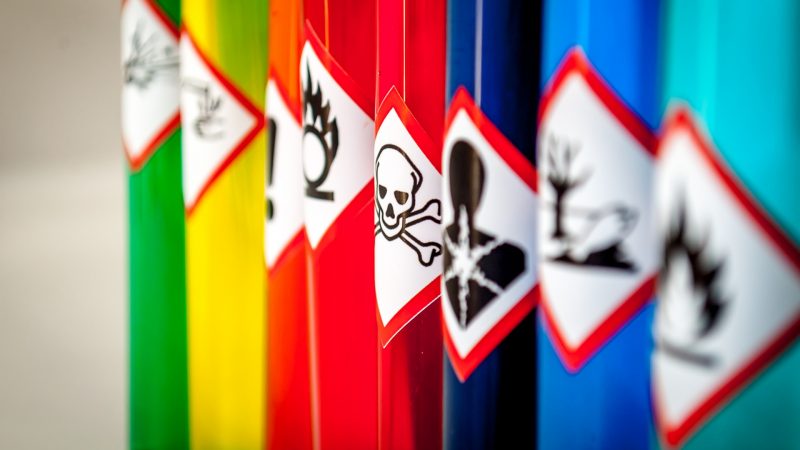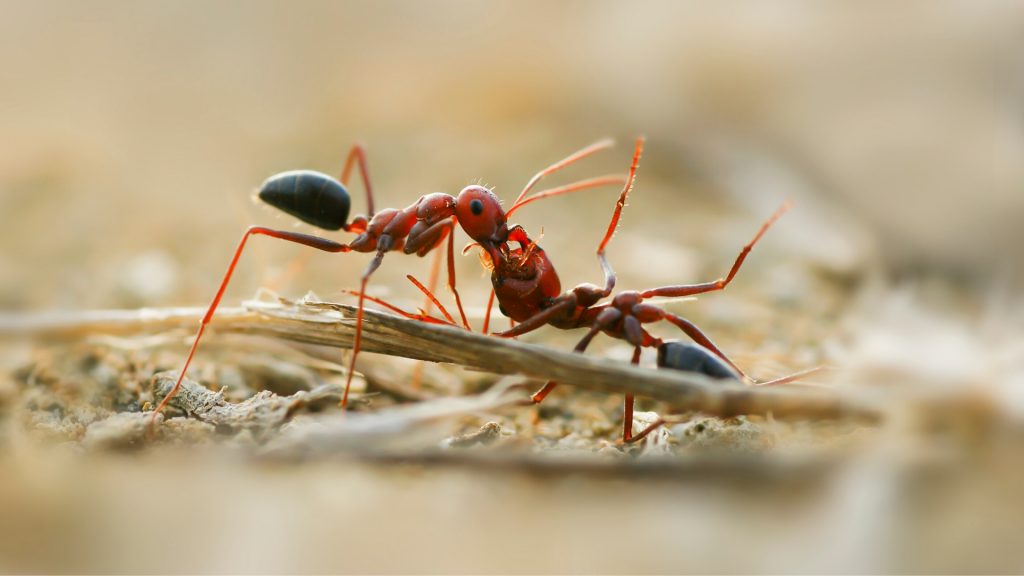It’s a common misconception that every bug can be killed with the same chemicals. Sure, some chemicals work better than others but pests have adapted to some products over time, which is why not every chemical can kill every insect.
According to the Journal of Exposure Science and Environmental Epidemiology, the most used chemicals exterminators use for ants are:
- pyrethroids
- pyrethrin
- Piperonyl Butoxide
- Hydramethylnon
- Methoprene and Pyriproxyfen
- Neonicotinoids
- Avermectin
- Fipronil
- Fenoxycarbs and Indoxacarbs
- Metaflumizone
- Carbamates and Organophosphates
Beware that every exterminator has a different mixture (formula) and ratio, which is more or less the same in terms of ingredients. One exterminator might add 50% of “X” and 50% of water or something else, while the other can have a different ratio.
In this article, we’ll talk about different chemicals exterminators use to kill ants. Grab your cup of coffee and stay with us. Let’s begin!
List of Ant Control Chemicals

Before paying for an exterminator, be sure to choose the reputable one. The reason is that they will have higher standards and will be able to explain for chemicals they are using on why they are using them. They will also be able to advise on any potential health risks.
For example, chemicals like chlorpyrifos, diazinon, and organophosphates, in general, have been forbidden by the Environmental Protection Agency since 2001.
So, if your exterminator tells you he’s using one of these, you should look for the other one. Here are the typical chemicals that exterminators usually use for ants:
Pyrethroids and Pyrethrins
When talking about the most common ingredients in insecticides, permethrin is in the first place. Of course, only licensed exterminators are allowed to use this chemical.
This chemical is just one part of a huge class of insecticides better known as pyrethroids. Pyrethroids and pyrethrins work in a very similar manner – they paralyze the ants, which eventually kills them.
Furthermore, pyrethroids mimic pyrethrins, and pyrethrins are botanical insecticides derived from chrysanthemum flowers. Almost 4,000 registered products used for households’ exterminations contain these chemicals. They’re also included in agriculture, mosquito control, and pet protection.
Why are they so widely used? Well, because they’re very safe for both humans and animals, as they don’t trigger any allergic reactions or asthma. The downside is that they’re toxic for fish and other aquatic organisms, so you should never throw them in the river.
Piperonyl Butoxide
Piperonyl butoxide often works in conjunction with MGK-264 substance. These substances aren’t pesticides, and because of that, they can’t kill ants alone. When added to pyrethrins and other substances, they act as enhancers, strengthening the insecticide’s effect.
Although EPA classified piperonyl butoxide as a carcinogen, they also say it isn’t toxic to humans. On the other side, allergic reactions like diarrhea and vomiting can be caused.
Hydramethylnon
Hydramethylnon doesn’t seem very effective at first. This is because it slowly kills the insects like cockroaches, termites, and of course, ants. This is among the most popular insecticides for ants, and many exterminators use it.
When you apply the chemical, the ants that come in contact become lethargic. They will start to grow weaker and die in three or four days. Although it will not kill all the ants immediately, it’s a great long-term solution.
If some insects are alive, for example, they’ll gather again and try to retake their position. But, with hydramethylnon in place, they will not be able to do that. What about its health risks, though? EPA also classed this one as a potential carcinogen.
On the flip side, it isn’t that much toxic to humans, with possible respiratory tract and eye irritation if not used carefully.
Methoprene and Pyriproxyfen
These two substances fall under insect growth regulators. As their names imply, they work by slowing down or inhibiting the insect’s development from the initial stage to the adult stage. Although they work on every type of ant, exterminators mostly use them to eliminate fire ants.
In terms of toxicity to humans, methoprene and pyriproxyfen aren’t toxic to humans. But, similarly to pyrethrins and pyrethroids, they’re very toxic to aquatic animals. It’s always recommended that your exterminator disposes of them properly e.g. don’t throw them in water.
Neonicotinoids
Neonicotinoids probably sound familiar to you. If you’re growing some plants in your yard, you’ve probably used them to repel bees or other insects that might do some damage. Interestingly, these are relatively new chemicals, first introduced in 1994 in the USA.
This group of chemicals is found in pollen and nectar of some plants and is very toxic to bees. Chemicals like clothianidin, imidacloprid, thiamethoxam, and acetamiprid are typical of this group. They’re vastly used for indoor ant control in either liquid or gel.
If your exterminator uses it, chances are you have carpenter ants, fire ants or Argentine ants, as neonicotinoids work flawlessly against those insects. But, neonicotinoids, despite posing a moderate threat to human health, should still be used carefully.
Since they get into your body via the skin, you should never touch the treated place. Furthermore, neonicotinoids can negatively affect your nervous system. For example, imidacloprid is known for reducing sperm counts in some animals during long-term exposure.
Avermectin

Avermectin is a very effective insecticide against Argentine ants, fire ants, and carpenter ants. Since these 3 are the most common culprits, this chemical has become very popular among exterminators in the USA. Baits that contain avermectin are often found in granules and not liquids or sprays.
In its pure form, abamectin or Avermectin has very high toxicity. But, for killing ants, only a small concentration of this chemical is used, which isn’t as toxic in this case. If you are exposed to Avermectin, know that it is toxic to your nervous system. And if you’re a woman, it can tamper with the fetus’s development in the early stages of pregnancy.
Thankfully, you can’t absorb higher amounts of this chemical through your skin.
Fipronil
Fipronil is yet another possible carcinogen, as claimed by EPA. Yet, it’s effective at killing all types of ants, including Argentine ants, carpenter ants, and fire ants. It comes in multiple forms, including granules, gels, liquids, and even impregnated materials.
The chemical has a very strong effect on ants, but unfortunately, it’s also very toxic to humans when ingested. It can be absorbed through the skin but not entirely. The effect is concentrated on the nervous system in both ants and humans.
Fenoxycarbs and Indoxacarb
Fenoxycarbs are used specifically for fire ants and rarely for other types of ants. These granules have low toxicity and aren’t absorbed well through the skin. But, if exposed to them in the long run, they can be toxic to your liver and represent a possible carcinogen, as implied by EPA.
Indoxacarbs are very similar, as they’re used for fire ants and come in granules. The toxicity is also low, and side effects are the same, with the difference being that indoxacarb is slightly less toxic.
Metaflumizone
Once again, a chemical for killing fire ants – metaflumizone. Metaflumizone comes in two shapes, either pelleted or granular. With low acute toxicity to humans, it’s relatively safe to use in households’ exterminations.
Carbamates and Organophosphates
Carbamates are often used as herbicides or insecticides with the ability to affect the nervous systems of humans and insects. They interfere with the transmission of nerve impulses by inhibiting an enzyme called cholinesterase.
Typical representatives of carbamates include carbaryl, aldicarb, carbofuran, butylate, and thiobencarb.
Organophosphates do the same as carbamates, but different chemicals represent them. Some of them are diazinon, phosmet, malathion, chlorpyrifos, and azinphos-methyl. In the beginning, we said that these were forbidden, but they were used before the 2000s.
The reason for their removal is that they’re hazardous to children. Furthermore, some of these chemicals are possible carcinogens and neurotoxic at low doses.
Should You Use These Chemicals on Your Own?
Never! The chemicals mentioned above are dangerous if not handled correctly, so they should only be used by trained professionals. Chemicals like these are used only by licensed exterminators who know how to handle them without posing a threat to the environment.
If you want to kill ants in your house without the help of an exterminator, we recommend using only the safe pesticides you can buy on Amazon or any other reliable vendor.
- OPTIMAL CONTROL: Optigard Ant Gel Bait from Syngenta is a...
- EASY APPLICATION: This stainless, odorless ant bait is known for...
- TARGETS ALL MAJOR SPECIES: The sugar-based gel matrix of Optigard...
- EFFICIENT ANT CONTROL: Other baits can be too runny, which...
- COMPACT PACKAGING: Optigard Ant Gel Bait is packaged in...
- Metal Ant Killer Bait: Attracts and kills many different species...
- Food Lure Ant Bait: The child-resistant metal bait stations use 4...
- How it Works: Worker ants carry and share the bait with the rest...
- Quick Results: Starts killing worker ants within 24 hours; you...
- Usage: Homeplus Ant Killer AB baits are great for getting rid of...
Now that you’re at the end of this article, please take all this as strictly informational and do not attempt to use these chemicals yourself. Knowing what your exterminator plans to use to kill ants is good, as you can have a conversation and choose the best option.
The primary concern when eradicating ants or any type of pests should be preserving your health. If your exterminator doesn’t tell you about the chemicals they plan to use, we suggest looking for a new one. An ant infestation can be terrifying, but with the right professionals, you can get rid of them quickly without endangering your health. Best of luck!
List of Sources
Pyrethrins and Pyrethroids, United States Environmental Protection Agency
Jiang W., Soeprono A., Rust M.K., Gan J., Ant control efficacy of pyrethroids and fipronil on outdoor concrete surfaces, Department of Environmental Sciences, University of California
Reregistration Eligibility Decision for Piperonyl Butoxide (PBO), United States Environmental Protection Agency
Hydramethylnon, United States Environmental Protection Agency
Methoprene, National Center for Biotechnology Information, PubChem Database. CID=5366546
Pyriproxyfen, National Center for Biotechnology Information, PubChem Database. CID=91753
Eco-toxicological effects of the avermectin family with a focus on abamectin and ivermectin, Bai S.H., Ogbourne S.
Tingle C.C., Rother J.A., Dewhurst C.F., Lauer S., King W.J., Fipronil: environmental fate, ecotoxicology, and human health concerns, Natural Resources Institute, University of Greenwich at Medway
Fenoxycarb, National Center for Biotechnology Information. PubChem Database. CID=51605
Fact Sheet for Indoxacarb, United States Environmental Protection Agency
Takagi K., Hamaguchi H., Nishimatsu T., Konno T., Discovery of metaflumizone, a novel semicarbazone insecticide
Organophosphate and Carbamate Pesticides, Delaware Health and Social Services
- How to Get Rid of Copperheads | Practical Guide - August 27, 2023
- How to Get Rid of Corn Snakes | What Makes Them Aggressive? - August 27, 2023
- How to Get Rid of Alligators | Safety Measures and Removal Methods - July 16, 2023


